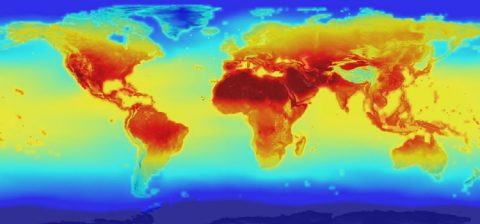
Opwarming aarde kost wereldwijd $ 2.500 mrd. Of misschien wel bijna het tienvoudige
8 april 2016 – De London School of Economics is aan het rekenen geslagen. Hoe meer de aarde opwarmt, hoe duurder het wordt: het begint bij $ 2.500 mrd en kan oplopen tot $ 24.200 mrd. Nature Climate Change bericht erover.
Uit het bericht van Nature Climate Change
‘(…) Investors and financial regulators are increasingly aware of climate-change risks. So far, most of the attention has fallen on whether controls on carbon emissions will strand the assets of fossil-fuel companies. However, it is no less important to ask, what might be the impact of climate change itself on asset values? Here we show how a leading integrated assessment model can be used to estimate the impact of twenty-first-century climate change on the present market value of global financial assets. We find that the expected ‘climate value at risk’ (climate VaR) of global financial assets today is 1.8% along a business-as-usual emissions path. Taking a representative estimate of global financial assets, this amounts to US$2.5 trillion. However, much of the risk is in the tail. For example, the 99th percentile climate VaR is 16.9%, or US$24.2 trillion. These estimates would constitute a substantial write-down in the fundamental value of financial assets. Cutting emissions to limit warming to no more than 2 °C reduces the climate VaR by an expected 0.6 percentage points, and the 99th percentile reduction is 7.7 percentage points. Including mitigation costs, the present value of global financial assets is an expected 0.2% higher when warming is limited to no more than 2 °C, compared with business as usual. The 99th percentile is 9.1% higher. Limiting warming to no more than 2 °C makes financial sense to risk-neutral investors—and even more so to the risk averse. (…)’
Uit een bericht van Z24 over het onderzoek
‘(…) Klimaatverandering leidt tot extremere weersomstandigheden, die onder meer de arbeidsproductiviteit en lonen negatief beïnvloeden. Stormen zullen gebouwen en infrastructuur vaker beschadigen en verzekeraars met grote kosten opzadelen. Als het warmer wordt, werken mensen bovendien minder hard, mislukken oogsten vaker en stijgen de voedselprijzen, stellen de onderzoekers.
Tijdens de klimaattop in Parijs december vorig jaar hebben 195 landen afgesproken om de temperatuurstijging op aarde te beperken tot maximaal twee graden Celsius, met 1,5 graad als streefwaarde. Veel wetenschappers beschouwen een sterkere opwarming als onomkeerbaar schadelijk voor de aarde en de opmaat voor extreem weer.
Als landen zich aan de in Parijs gemaakte afspraken houden dan verdampt ten hoogste 315 miljard dollar aan activa, ook als de kosten van het terugdringen van broeikasgassen daarbij worden opgeteld, becijferde de London School of Economics.
Het World Economic Forum noemt een natuurrampen als gevolg van klimaatverandering de grootste bedreiging voor de wereldeconomie. (…)’
Uit een bericht van CNBC
‘(…) “Our results may surprise investors, but they will not surprise many economists working on climate change because economic models have over the past few years been generating increasingly pessimistic estimates of the impacts of global warming on future economic growth,” Simon Dietz, the paper’s lead author, said in a news release. (…) Keeping warming to 2°C was seen by the study’s authors as being important. “When we take into account the financial impacts of efforts to cut emissions, we still find the expected value of financial assets is higher in a world that limits warming to 2°C,” Dietz said. (…)’
Bronnen
Nature Climate Change, 4 april 2016: ‘Climate value at risk’ of global financial assets (kosten volledige artikel € 30)
Z-24, 7 april 2016: Opwarming van de aarde kost beleggers al snel 2.500 miljard’
CNBC, 5 ap[ril 20126: Global warming risks trillions: Study
London School of Economics/Grantham Research Institute on Climnate Change and the Environment, persbericht, 4 april 2016: New study estimates global warming of 2.5 centigrade degrees by 2100 would put at risk trillions of dollars of world’s financial assets
Kaart: NASA



